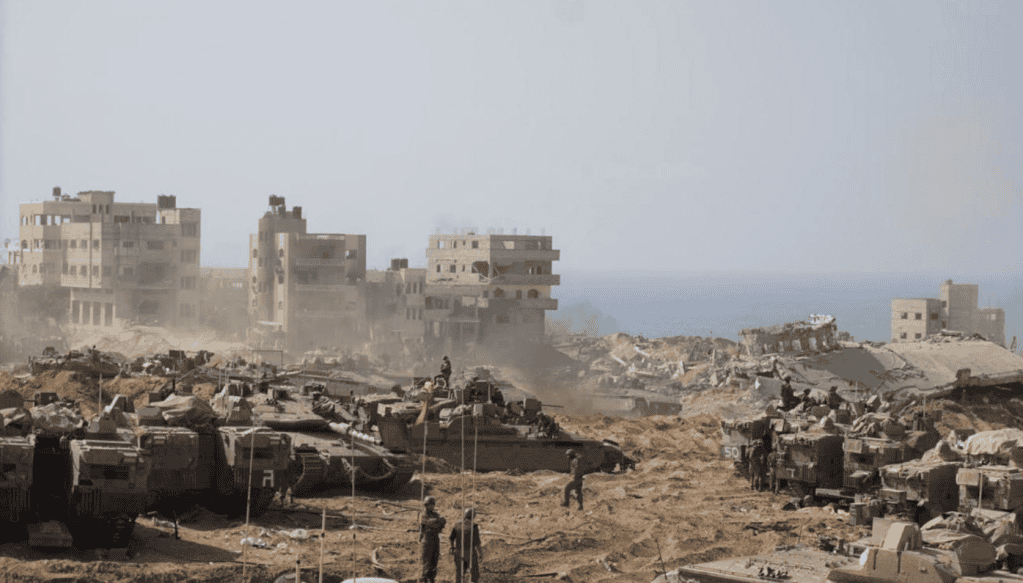
Seth Frantzman is reporting from Israel.
The Israel Defense Forces succeeded in encircling Gaza City in the first week of the ground offensive and have now begun to spread out and settle into their operational areas. That incudes units from two separate IDF divisions, the 36th and 162nd Divisions.
The IDF described the activities of the 36th Division on Sunday as expanding ground operations since last week. “The 36th Division has operated in the northern Gaza Strip and reached positions along the coast of Gaza. The role of the division is to encircle Hamas forces in Gaza City, and to strike and destroy select targets, including significant assets and command and control centers belonging to the Hamas terrorist organization,” the IDF said. The 36th Division has struck 1,600 targets in Gaza since ground operations began on Oct. 27. They have also eliminated 300 terrorists, according to the IDF.
At the same time, elements of the IDF Golani reconnaissance unit reached the coast on Nov. 4, after crossing from the east, essentially cutting off Gaza city from southern Gaza. That means Israel now controls the key roads that link the north and south. The central road is called Salah al-Din and there is a coastal road named Rashid. These are key avenues for civilians to leave northern Gaza. Israel has called on civilians to leave the north, and many have fled the fighting. However, many remain. “We have arrived at the beach, and they are strengthening this line. We continue to allow for a corridor in order for the residents of northern Gaza and Gaza City to move southward,” the IDF said over the weekend.
The humanitarian issue is a concern and the IDF’s Coordinator of Government Activities in the Territories (COGAT) put out a video of one of its members giving a statement encouraging civilians to use the humanitarian corridor south. While the IDF stresses the work it has done to spread the word, dropping pamphlets and making calls to encourage people to go south, it also says that Hamas is using hospitals and other facilities, and exploiting civilians as human shields.
The week-long ground offensive has now achieved its initial aims. Cutting the Gaza Strip into two pieces means the IDF can now concentrate on isolating Gaza City. That is where many Hamas tunnels are located and also where key facilities, such as Shifa hospital, are located. It is also where numerous rocket launchers are positioned to fire rockets north towards Tel Aviv, Ashdod and other areas. Over the last week in Sderot, we witnessed numerous rockets launched from areas near Gaza City, illustrating that despite the IDF’s increasing encirclement, Hamas or other groups can still sustain their attacks. While Hamas continues to fire barrages of rockets, it has generally reduced this rocket fire to one or two large barrages a day, generally after nightfall and aimed at central Israel.
As the IDF settles in and gets to know their areas of operations in Gaza, they have also used the time to uncover terrorist infrastructure. Some of this had been struck from the air in the past month, including 11,000 targets struck between Oct. 7 and Nov. 1. However, many rocket launch sites and tunnels evade these strikes. “During activity by a team of soldiers of the 460th Brigade to locate terrorist infrastructure and clear the area, rocket launch pits found by the soldiers in a mosque were destroyed,” the IDF said on Monday. Targets continue to be struck from the air, including 450 strikes alone between Nov. 5-6, but there are now more strikes on the ground using artillery and tanks and close coordination between ground forces and the air force.
For instance, IDF Chief of Staff Herzi HaLevi praised an F-35 squadron for carrying out a strike within 200 meters of ground forces. “We haven’t done this before, with very heavy armament, very good communication between what the force needs and what the jet knows to provide, and this connection of air and ground together, we always knew it was strong, we see that it is much stronger than we thought,” HaLevi said in a statement.
Israel continues to suffer casualties in the fighting. Some 348 IDF soldiers have been killed since Oct. 7, many of them during the initial Hamas attack that first day when hundreds of soldiers and more than 1,000 civilians were massacred. An additional 240 people are held hostage in Gaza. There have also been attacks elsewhere. A policewoman was stabbed and killed in Jerusalem on Nov. 6 and anti-tank and missile fire from Lebanon continues to land in northern Israel.
Israel Minister of Defense Yoav Gallant approved additional plans on Monday in an effort to continue to eliminate Hamas “company commanders and battalion commanders.” The IDF claims to have killed 12 Hamas battalion commanders prior to Nov. 4.







